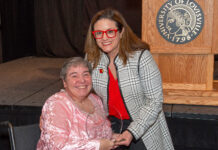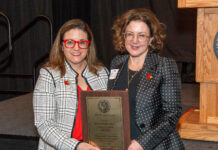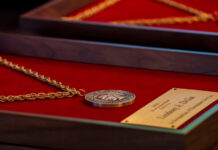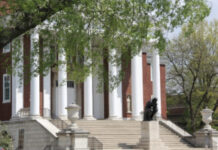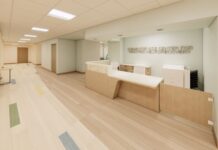Stacks of bricks sat outside the shed.
The students’ task, over the following weeks, was to use them to build a new wood-burning kiln. But there was more to the project, in ceramics professor Todd Burns’ mind, than mixing mortar, laying bricks and using power tools.
Burns also wanted to build community. Throughout August, the students constructed the University of Louisville’s first wood-burning kiln. In early September they met in class and created the pieces that would be in the kiln’s first firing. Then they spent one weekend at the kiln site, feeding a fire log by log to bring the inside kiln temperature to 2,350 degrees Fahrenheit, while their dried-clay pieces turned into hardened ceramics.
During the firing, just watching them laughing and talking and smiling with each other, and learning more about each other and enjoying each other’s company, I could tell that it was a good decision to build the kiln, Burns said.
Students don’t always have a feeling of investment in their program or department or the university at large, he continued. Something like this – that requires a group effort from the construction of it, to the loading and preparation of the fuel, to the firing – creates a real opportunity for the students to feel connected to their program, to feel like what they’re doing is important.
More than in any other type of firing process, human input – from the placement of the pieces in the kiln, to adding fuel (wood) to the fire – is critical to the outcome of wood-fired ceramics.
The whole process originated centuries ago in China.
This is a very ancient technique that can be used in the 21st century environment, Burns said. I want (the students) to think about the wood kiln as a research tool, since that’s our university’s mission.
Firing ceramics always involves mystery. Even with gas and electricity fuel sources it can be difficult to accurately predict the exact way a finished piece will look.
With wood-fired ceramics, the mystery may be even greater.
As wood ash flies through the kiln like snowflakes, it lands on pieces and creates its own unique glaze as it melts in combination with the clay surface, Burns said.
The flame itself carries volatile gases that contain potassium, sodium and other soluble materials that the tree drank up with the water that it used to grow, he continued. As it moves through the kiln, the flame leaves a vapor trail that flashes the clay when it makes contact with the pieces. The result is brighter salmon, pinks and orange colors on the pieces.
Students saw firsthand the difference in appearance between wood-fired glaze and glazes fired in electric or gas kilns the Wednesday following the weekend firing when they gathered again in the shed to unload their work.
Artist-in-Residence Jeff Campana and student Tristan Clinger removed one or two bricks at a time to open the kiln, laying them on a pallet in the order in which they took them down. As the opening grew, students gathered around to get a glimpse of the finished pieces and talked about what they saw. Some took photos with their cell phones.
The class celebrated the occasion with homemade Neopolitan pizza cooked in another of their creations – a pizza oven they made with leftover materials from the kiln.
Burns has scheduled another firing for November. In the meantime, they are back in class creating more wares for firing.
I think right now they are spending time with their pieces trying to reflect on how they want to change what they make, the shapes of what they make, and the glazes they apply to the surface or whether they choose to apply any at all, Burns said. They’re kind of reflecting on what type of outcome they want next time.












